Eyes of Non-travelers: The Socialism Paradise of Beijing
What if the air of the 21st century Beijing still covered by the bravado of Cultural Revolution and the 2008 Olympic host city become a Maoist paradise? You may see the extraterrestrial architecture of China Central Television building worshipped by thousands of comrades chanting rouge slogans marching down the road. Or office workers work happily with their desktop computers, along with smiling cleaning staffer, and surrounded a parade of curious working class visitors with their happy faces and red flags.
All of this imagination is portrayed in several paintings made by North Korean propaganda artists. The idea and effort of this project came from Beijing-based British expat duo, one of which runs the travel company specializing in trips to the Democratic People’s Republic of Korea (DPRK, known better as North Korea). The duo showed some daily life photos of Beijing to the artists from the hermit kingdom, and invited them to visualize the life of the modern city they have never visited.

Sea of happy people next to CCTV Headquarters

A journey to the promised land

Chinese tourist with camera in front of Bird’s Nest

Red Guards in KTV
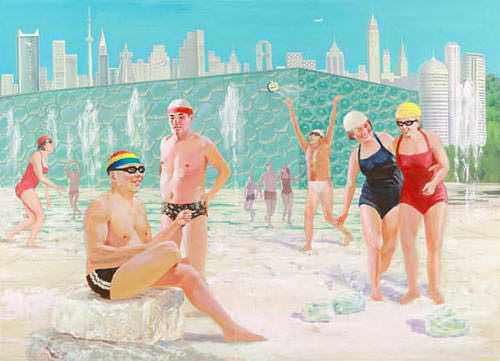
No bikini
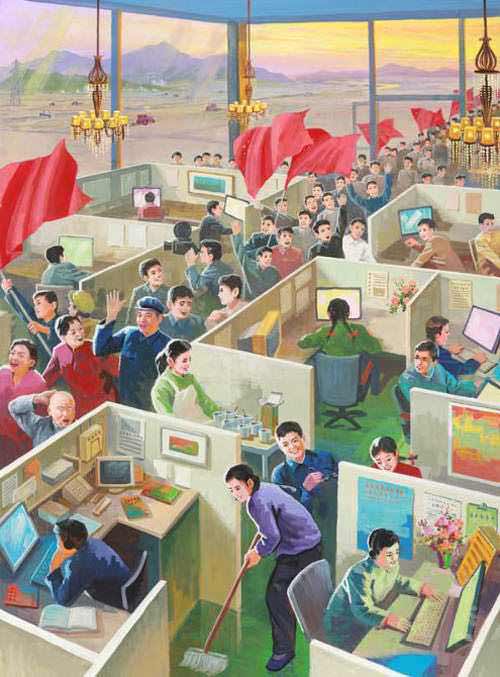
Happy office
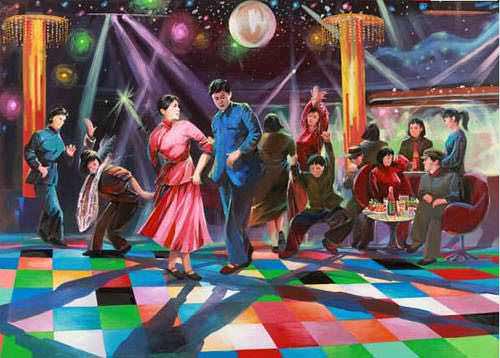
Let’s go disco

Future of China
One of the paintings is the gigantic China Central Television (CCTV) headquarters with its bizarre twisted loop (the Chinese nicknamed it as “Giant Underpants”), surrounded by fertile paddies promising a great harvest. The building radiates a kind of golden sheen, and you can see vapor trail of three planes maneuvering towards the sunset. Far in the foreground, Chinese farmers are rejoicing, along with male and female Red Armies celebrating their arrival to the promised land of socialism.
In other paintings showing the skyline of Beijing, you always see at the background a battalion of factories producing fumes to the pinky sky—a North Korean dream of modernization, but surely will not be celebrated with smiling faces by the real Beijingers who were just choked by black smog a week earlier.
Other interesting paintings are the pink cheeked Red Armies with old fashioned Mao-style uniforms sing happily in KTV. I wonder what songs they are singing, for sure “Unity is Power” and “The Red Sun” are in the list. I think the painters might be shocked to death had they seen how young Beijing women now go to Karaoke wearing miniskirts, tank tops, or being fashionable with South Korean fashion—evil things, as their Great Leader used to say.
The six paintings arouse discussion and mocking among Chinese netizens about their northern neighbor. But you can’t totally blame the North Korean artists, as they have to chase deadline fulfilling their duty of drawing places they never visited, they only can draw “Beijing in their heart”.
If you see the elements of the paintings are actually very real: the buildings are real, the KTVs are real, and even the tourists with camera on neck and the marching Red Guards are also real. But why the combination of all of these produces such an eerie feeling?
This is a problem of visualization of concepts. The sophisticated 21st century architecture in Beijing can be simplified with the lines, curves, colors, shapes, as how the photos they received already show the physical concept of the buildings. The next question is how to picture life, a spiritual concept, in a faraway land impossible to visit? Having no rights to travel abroad, the North Korean artists may only visualize Beijing through the images and concepts familiar to them: marching parade with flags, slightly smiling faces, Great Leader, red flags, equal costume of working class, factories with fumes. The result is “real things but false atmosphere”.
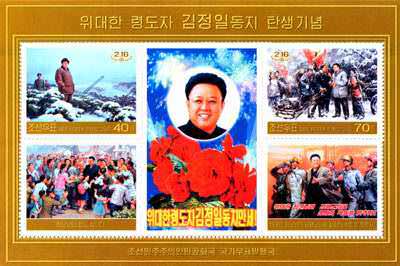
North Korean stamps promise dreams to philatelists
![Chinese poster: "John rides the ox and I am the horse, what a shame if he wins the game." [Shanghai Propaganda Poster Art Center]](http://agustinuswibowo.com/directory/wp-content/uploads/131210-north-korean-painting-11.jpg)
Chinese poster: “John rides the ox and I ride the horse, what a shame if he wins the game.”
[Shanghai Propaganda Poster Art Center]
![Chinese poster: "Long Live the Victory of the People's Army of Korea and Voluteray People's Army of China" [Shanghai Propaganda Poster Art Center]](http://agustinuswibowo.com/directory/wp-content/uploads/131210-north-korean-painting-10.jpg)
Chinese poster: “Long Live the Victory of the People’s Army of Korea and Voluteray People’s Army of China” [Shanghai Propaganda Poster Art Center]
North Korean propaganda artists are famous in conveying their message through paintings. When I was younger, I was a fanatic collector of North Korean stamps. Like them, I was also “locked” in my little village and may only dream about the outside world. The pictures on North Korean stamps used to bring sweet dreams to my nights: dreams about a modern, futuristic nation with skyscrapers, sea of happy and healthy people, sophisticated rockets on its journey to the moon. Living in Indonesia with the anti-Communism spirit of the New Order, the socialist countries are totally another world, colors on map we know nothing except its names and capital names. Because of the beautifully designed stamps (similar to Beijing paintings you see above), I really dreamed to visit the country, to enjoy life in such a “paradise”.
As a Chinese-Indonesian, I was also raised with a paradise image of my ancestral land. My mother used to tell fairy tales of the homeland she never visited. There is paradise, a land where we can live happily with no race discrimination, she once said. When I arrived in Beijing for the first time in year 2000, I was welcomed by harsh winter, sandstorms, and authorities treating us merely as foreigners. We were not allowed to live with the locals, we were only to stay in special dormitories (and expensive!) for foreign students. Once I smuggled a Chinese friend to my dormitory room, I was scolded by the matron as my deed may cause “messiness” and “danger” to us their “international friends”.
In the other side of the world, our archipelago is also often drawn as a paradise for the Europeans. Palm trees, no winter, breathtaking sunset with breathtaking beach, exotic tradition, naked women, etc. Five centuries ago, they started perilous journey across the ocean to find the paradise islands producing the luxurious spices. The Westerners also called Bali as “paradise on earth” much before we realized it (I started to realize how precious the blue sky we used to see every day in my Indonesian village after I lived in sandstorm-ed and grey-sky-ed Beijing).
Every of us “paint” our paradise. We are luckier than the North Koreans, as we have more access to information and much chance to travel the outside world. But it does not mean that we already draw the real “painting” of places.
Yes, you may see and visit the physical things: landmarks, historical sites, buildings, hotels, restaurants. You may experience at a glance, take some snapshots, go home and tell your friends: See, Barcelona is nice, Hong Kong is modern, Nepal is dirty, or Thai food is the best. Visiting a place doesn’t guarantee you to really understand the core of the places: the essence of the culture, the complexities of the society, dreams and fears inside the head of the people, etc. Thus we also make “fake” paintings of places and broadcast it to everybody. Life without traveling is like a frog under a coconut shell (the Chinese says: a frog inside a well). But traveling without understanding the “soul” of places is not much better.
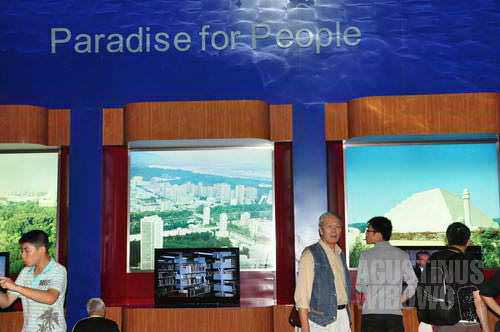
North Korean pavilion in World Expo Shanghai 2010, “Paradise for People” in such a modest pavilion (Agustinus Wibowo)

North Korean ladies offering propaganda stamps, books authored by the Kims, and other memorabilia from the hermit kingdom in World Expo Shanghai 2010 (Agustinus Wibowo)
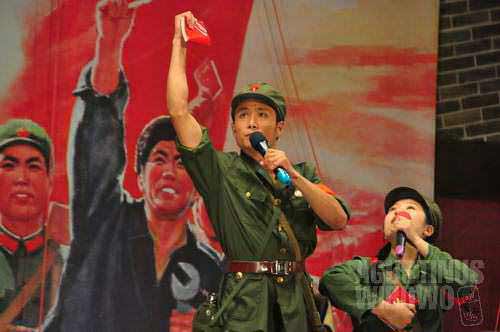
A Beijing restaurant brings back the nostalgic atmosphere of Cultural Revolution (Agustinus Wibowo)
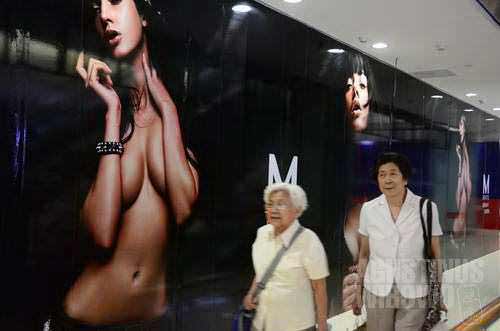
The reality of Beijing today, which the North Korean might never even dare to imagine (Agustinus Wibowo)
To some extremes, the “false paintings” may lead to potent dangers: stereotyping, conflicts, even wars and terrorisms. Some people in our country dreams of an Islamic paradise (having a country like Saudi Arabia or Afghanistan or Iran without ever living there), and forcing others to accept their “painting of paradise” as fact of reality. Some other people also paint rosy pictures of American Dreams or Western Dreams, here we see many Iranian and Afghan refugees putting their future and life at stake in a dangerous journey from Indonesian islands to Australia (most end up in jails if not dead in the ocean), for a happiness which may not be possible or necessarily real. The “paradise in mind” is similar with “hell in mind”. See how some our Indonesian brothers, with clear idea of how a total evil Israel is, have hatred ingrained into bones against the whole country and people they have never seen in life. Similarly, some (powerful) people in the West think that world would be a better place if all countries adopt the same system of freedom and democracy, pushing the countries to accept their painting of Better New World, neglecting the complexities of “soul” of different countries and nations, and the result is endless conflicts and chaos.
The Chinese has saying, “One who retreats fifty paces mocks one who retreats a hundred.” No matter you retreat fifty paces or a hundred paces, you still retreated. So, rather than mocking on paintings made by the North Korean, let’s put an effort to make our own better “painting” of the world around us.



Leave a comment